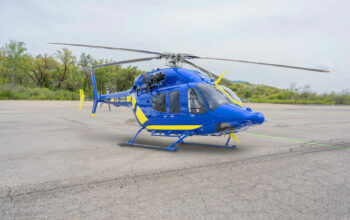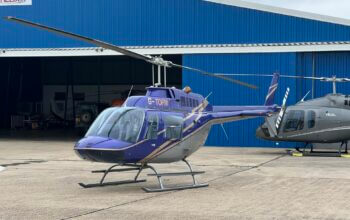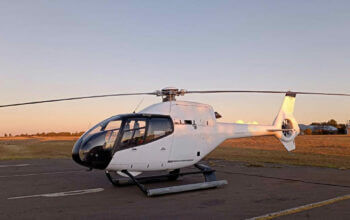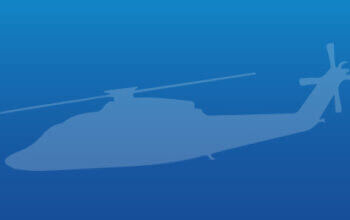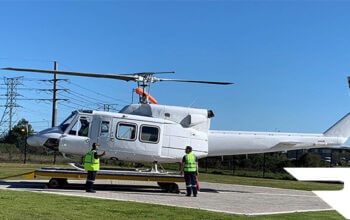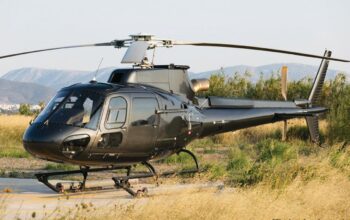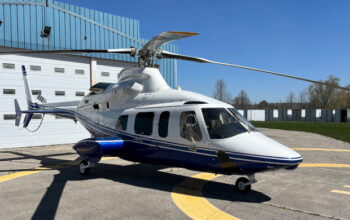Estimated reading time 14 minutes, 45 seconds.
Embraer has made several announcements from the Paris Air Show.
Embraer begins assembling the first E190-E2
Two years after the launch of the program, at the Air Show in Le Bourget, Paris, the first of the E-Jets E2 family, an E190-E2, is beginning to be assembled at the company’s factory in São José dos Campos. Embraer has already received the first sub-assemblies from suppliers in several countries and the assembly of the first prototype is moving forward as planned.
“It is exciting to see the E2 taking shape with the large amount of sub-sets arriving to our São José dos Campos facility, where the final assembly will soon begin,” says Luís Carlos Affonso, senior vice president and COO, Embraer Commercial Aviation.
At Embraer’s plant in the city of Évora, Portugal, the first sub-assemblies for the wings and central fuselage are ready. In Spain, Aernnova AEROSPACE S.A. is finishing the assembly of the vertical empennage – the company will also supply the horizontal empennage. In the Czech Republic, Latecoere finished the baggage doors and they have already been sent to Brazil to be installed in the aircraft.
In the United States, Triumph Aerostructures, which is also responsible for the rudder and elevator, is assembling section tree and the aft of the fuselage; these are the only large segments that will not be manufactured by Embraer.
In Brazil, at the Botucatu plant, Embraer has already produced a series of components for the wings, central fuselage one and two, besides the finish of the forward fuselage; this segment is in the final assembly stage in São José dos Campos. All of these structures will be highly automated in the manufacturing stages.
Eleb, an Embraer wholly owned subsidiary, with 35 years of experience in designing and manufacturing landing gear, was chosen to supply the landing gear of the second-generation E-Jets, and it is working to conclude the first sets.
Testing is also moving ahead at an accelerated pace. At the Eugênio de Melo plant, the different static test rigs are working and allowing Embraer to develop such systems as fly-by-wire, with laws and codes that are being developed by the company, itself, and the integrated functions with other aircraft structures.
The first delivery of an E-Jets E2 (the E190-E2) is planned for the first semester of 2018. The E195-E2 is scheduled to enter service in 2019 and the E175-E2 in 2020. The E-Jets E2 program reinforces Embraer’s commitment to continuously invest in the company’s line of commercial jets and to maintain leadership in the 70 to 130-seat aircraft segment. Embraer’s E-Jets E2s have state-of-the-art Pratt & Whitney PurePowerTM Geared Turbofan high by-pass ratio engines (PW1700G on the E175-E2, PW1900G on the E190-E2 and E195-E2). Combined with new aerodynamically advanced wings, full fly-by-wire flight controls, and improvements to other systems, the E2s will deliver significant reductions in fuel burn, maintenance costs, emissions, and external noise.
SkyWest, Inc. confirms order for eight E175s additional aircraft to fly for Alaska Airlines
Embraer S.A. and SkyWest, Inc. (SkyWest) have announced at the 51st International Paris Air Show, a firm order for eight E175 jets. The aircraft will be flown by SkyWest Airlines under a Capacity Purchase Agreemnt (CPA) with Alaska Airlines. The value of the contract, which will be included in Embraer’s 2015 second-quarter backlog, is estimated at US$355 million based on 2015 list prices.
This is the second agreement between SkyWest and Alaska Airlines involving the E175. In November of last year, the two companies signed a CPA for seven aircraft of the same model. The first airplane in Alaska Airlines livery enters service next month.
“We welcome this latest order confirmation from our longstanding customer,” said Paulo Cesar Silva, president and CEO, Embraer Commercial Aviation. “For almost thirty years, SkyWest has operated Embraer aircraft and their performance and reliability has helped build the carrier’s sterling reputation. I know that SkyWest and Alaska Airlines will appreciate the E175 for its excellent economics, as will their customers for the spaciousness of the cabin.”
These eight new aircraft are part of SkyWest’s previous order for 100 (40 firm and 60 reconfirmable) E175 current generation E-Jets – with an additional 100 options – placed in May 2013. This reconfirmation brings the total number of firm orders to 55 aircraft. The E175s for Alaska Airlines will be configured with 76 seats and include 12 First Class seats. Delivery for the additional eight E-Jets is scheduled for 2016.
“We are pleased to secure additional Embraer aircraft to fly in partnership with Alaska Airlines,” said SkyWest, Inc. president Chip Childs. “We appreciate our long-standing relationship with Embraer and continue to be impressed with the E175 product.”
SkyWest is the largest regional airline group in the world and is the parent company of SkyWest Airlines and ExpressJet Airlines. Both companies have long histories with Embraer and were early customers for the Embraer EMB 120 Brasilia turboprop aircraft. In a separate deal with Embraer announced in June of 2013, SkyWest became the launch customer for the E175-E2, ordering 100 aircraft with 100 additional options. Deliveries begin in 2020.
United Airlines to add more E175s to the United Express fleet
Embraer S.A. has announced at the 51st International Paris Air Show an agreement with United Airlines to add additional E175 jets to the United Express fleet. The agreement consists of ten firm orders, which will be included in Embraer’s 2015 second-quarter backlog. Additionally, Embraer expects that United or one of the carriers that operates as United Express will convert options for 18 aircraft to firm orders in the near term. The ten firm orders have an estimated value of US$444 million based on current list price.
Delivery of the first of these aircraft is expected in 2016. The E175s are configured in a dual class 76-seat layout and will operate under the United Express brand. The carrier’s 76-seat jet fleet will be comprised exclusively of E175s. This latest acquisition is in addition to a previous order from United Airlines for 30 E175s in April 2013.
“Selecting the E175 as the primary aircraft for its regional fleet shows the great importance United gives to both the satisfaction of its customers and the efficiency of the operation,” said Paulo Cesar Silva, President & CEO, Embraer Commercial Aviation. “Embraer and United have a long and strong partnership and we are proud that United has chosen, again, the E175, the most comfortable and the lowest operating cost in its category.”
“We are thrilled to add more E175s to the regional fleet. The E175 will be used to primarily replace older, less efficient 50 seat regional jets while providing an improved passenger experience” said Ron Baur, VP Fleet.
United’s E175 will be equipped with a 12 First class, 16 Economy Plus Seats, and 48 Economy seats. Wi-Fi will also be included.
The E175s feature a new wingtip that, among other technical enhancements, improves aerodynamic performance. Fuel consumption on a typical flight is 6.4 per cent lower than first-generation E175s. In North America, the E175 is the preferred aircraft of carriers operating 76-seat jets. In the last two years, the E175 has captured over 80 per cent of orders among aircraft in its class from airlines in the USA.
Embraer is the only manufacturer to develop a modern family of four airplanes specifically targeted for the 70- to 130-seat segment. Since the formal launch of the program in 1999, E-Jets have redefined the traditional concept of regional aircraft by operating across a range of business applications. The first E-Jet entered revenue service in 2004.
Aircastle signs firm order for 25 Embraer E-Jet E2s
Embraer and Aircastle Holding Corporation Limited, which is a subsidiary of Aircastle Limited (Aircastle), announced at the 51st International Paris Air Show a firm order for 25 E-Jet E2s, consisting of 15 E190-E2s and 10 E195-E2s with an additional 25 purchase rights for 15 E190-E2s and 10 E195-E2s, bringing the total potential order to up to 50 aircraft. The transaction will be included in Embraer’s 2015 second-quarter backlog.
Aircastle’s deliveries are scheduled to begin in 2018 for the E190-E2 and 2019 for the E195-E2 at a rate of roughly seven units per year through 2021. The new order brings the E-Jets E2 backlog to 267 firm orders plus 373 options and purchase rights.
“We have enjoyed working together with Aircastle on our current generation E-Jets, and now we are taking an important step forward in building this partnership with the E2 program. We will be working together for many years to come and are excited about Aircastle’s creative, flexible and nimble approach to doing business,” said Paulo Cesar Silva, president and CEO, Embraer Commercial Aviation. “This new contract is a clear demonstration of the great market potential that leasing companies are seeing for the E2s.”
“Embraer’s new E2 is an exciting new aircraft family that builds on the success and large global customer base of the current generation E-Jets while offering airlines significant new operating efficiencies and benefits,” said Ron Wainshal, Aircastle’s CEO. “We see the E2s as the clear category leader and are excited about the excellent investment value this opportunity represents. We are also pleased to expand on the warm relationship Aircastle has enjoyed with Embraer for many years and, indeed, are attracted to their strong, collaborative approach to working with lessors.”
The first E-Jet E2 (an E190-E2) is planned to be delivered in the first semester of 2018. The E195-E2 is scheduled to enter service in 2019 and the E175-E2 in 2020. The E-Jets E2 program reinforces Embraer’s commitment to continuously invest in the company’s line of commercial jets and to maintain its leadership position in the 70 to 130-seat aircraft segment. The E2s have state-of-the-art Pratt & Whitney PurePower Geared Turbofan high by-pass ratio engines (PW1700G on the E175-E2, PW1900G on the E190-E2 and E195-E2). Combined with new aerodynamically advanced wings, full fly-by-wire flight controls, and improvements to other systems, the E2s will deliver significant reductions in fuel burn, maintenance costs, emissions, and external noise.
Embraer projects 6,350 new jet deliveries in the 70 to 130-seat segment
Embraer has released its 2015-2034 Market Outlook which details forecasted deliveries of new aircraft over the next twenty years. The report focuses on the 70 to 130-seat capacity category which is valued at US$300 billion during that period. Embraer projects deliveries of 6,350 jets – 2,250 units in the 70 to 90-seat segment and 4,100 units in the 90 to 130-seat segment.
The 70 to 130-seat jet world fleet-in-service will increase from 2,590 aircraft in 2014 to 6,490 by 2034, the fastest growing among all aircraft seat segments. Replacement of ageing aircraft will represent 39 per cent of new deliveries and 61 per cent will represent market growth.
The capacity discipline strategy followed by North American carriers has proven to be very effective in generating higher profits. As airlines become more attractive to investors, Embraer also sees a shift in the main business goals from unit cost and market share to unit profit and return on investment.
“Right-sized aircraft can regularly generate higher revenue and profit per seat since they have fewer available seats allocated for low-fare passengers. High efficiency of assets is essential to sound financial performance. Those attributes — combined with hub-and-spoke efficiency, narrow-body aircraft complement and new market development — will generate significant demand for new aircraft in the segment”, explained Paulo Cesar Silva, president and CEO, Embraer Commercial Aviation.
Worldwide demand for air transport, measured by revenue passenger kilometers, will increase 2.6 fold at an average of 4.9 per cent annually through 2034. China and the Middle East will be the fastest-growing markets with an average annual RPK growth rate of around 7.0 per cent, followed by the emerging regions of Latin America with 5.9 per cent, Africa with 5.4 per cent, Asia Pacific and the Commonwealth of Independent States (CIS) with around 5.0 per cent and the mature markets of Europe and North America with 3.9 per cent and 2.7 per cent, respectively.
Notice a spelling mistake or typo?
Click on the button below to send an email to our team and we will get to it as soon as possible.
Report an error or typoHave a story idea you would like to suggest?
Click on the button below to send an email to our team and we will get to it as soon as possible.
Suggest a story